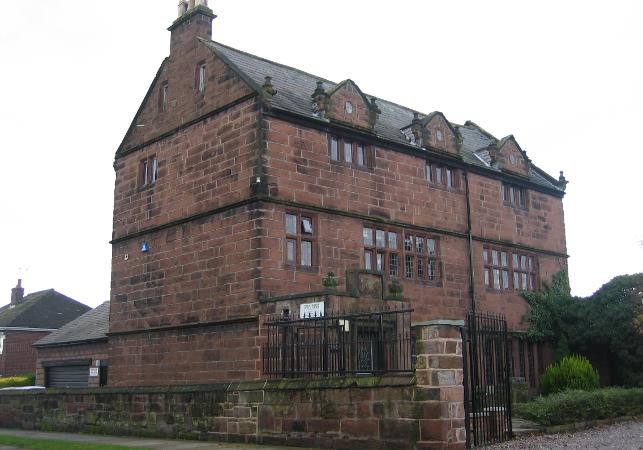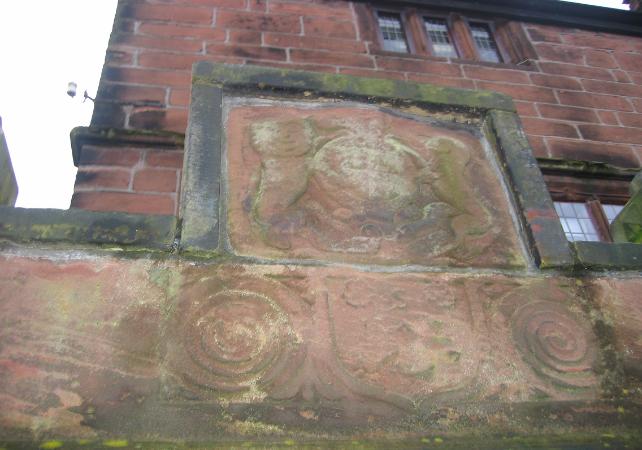






| MENU |


Stanhope House
This lovely looking old house is tucked away from the main road at Bromborough. It sits on the
corner of Mark Rake just off Spital Road next to the Brombrough public house. The building was lived
there for a short period of time and placed their initials above the doorway.. The house dates back
to 1693 and is a great example of Elizabethan Architecture despite being built at a later period. The
house is built from strong red sandstone which now looks a distinguished brown colour. The house
has many mullioned windows, two gables and 2 chimneys both of which are later editions from the
18th and 19th century. The house stood over 3 floors and even had a converted loft space. The
porch area is the most modern part of the building as it was added when the house was turned into
a public library just before the onset of war in 1939. It was at this time that the ground floor was
upper stories of the building were removed to make space. At a later date the oak panelling was
reinserted this time using oak from Chillingham castle in Northumberland. The land around the
house and indeed the walls of the gardens predate the house by some years. Upon careful
examination of the stone work around the gardens several marks and indentations can be made out.
It is widely believed that these are marks made by archers sharpening their arrows. This has been
proven in other places around the peninsula.
The picture below shows the coat of arms above the front doorway.
The house passed through many hands over the years and was eventually given back to Bebbington
Borough Council (now Wirral) in 1939 by a local builder who had acquired it in order to demolish it.
The council decided that the outstanding house would make a good location as a library and so they
set about refurbishing it.
Over the years following the house became neglected and the decision was taken to knock it down.
The council erected a large wooden structure in the front garden of the premises as a temporary
measure. The situation began to look bleak for the historical house until Mr Raymond Richards of
Gawsworth Hall stepped in and privately funded the complete restoration of the house. The building
remains unchanged from the date of refurbishment however it is now used as a commercial office for
a local company.
This lovely looking old house is tucked away from the main road at Bromborough. It sits on the
corner of Mark Rake just off Spital Road next to the Brombrough public house. The building was lived
there for a short period of time and placed their initials above the doorway.. The house dates back
to 1693 and is a great example of Elizabethan Architecture despite being built at a later period. The
house is built from strong red sandstone which now looks a distinguished brown colour. The house
has many mullioned windows, two gables and 2 chimneys both of which are later editions from the
18th and 19th century. The house stood over 3 floors and even had a converted loft space. The
porch area is the most modern part of the building as it was added when the house was turned into
a public library just before the onset of war in 1939. It was at this time that the ground floor was
upper stories of the building were removed to make space. At a later date the oak panelling was
reinserted this time using oak from Chillingham castle in Northumberland. The land around the
house and indeed the walls of the gardens predate the house by some years. Upon careful
examination of the stone work around the gardens several marks and indentations can be made out.
It is widely believed that these are marks made by archers sharpening their arrows. This has been
proven in other places around the peninsula.
The picture below shows the coat of arms above the front doorway.
The house passed through many hands over the years and was eventually given back to Bebbington
Borough Council (now Wirral) in 1939 by a local builder who had acquired it in order to demolish it.
The council decided that the outstanding house would make a good location as a library and so they
set about refurbishing it.
Over the years following the house became neglected and the decision was taken to knock it down.
The council erected a large wooden structure in the front garden of the premises as a temporary
measure. The situation began to look bleak for the historical house until Mr Raymond Richards of
Gawsworth Hall stepped in and privately funded the complete restoration of the house. The building
remains unchanged from the date of refurbishment however it is now used as a commercial office for
a local company.

